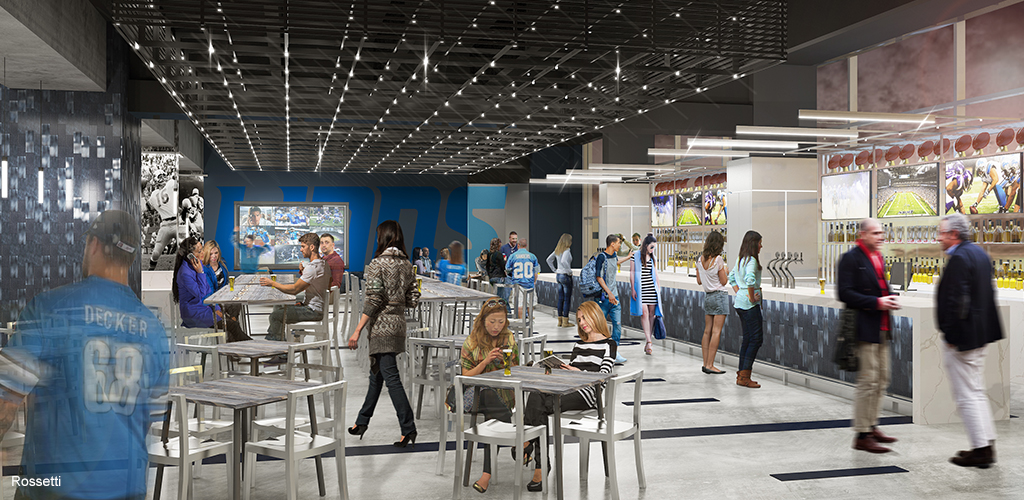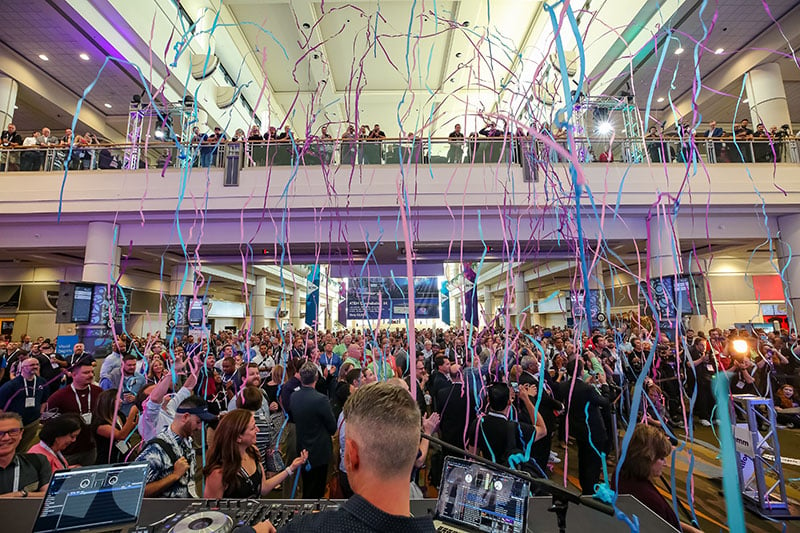Waiting in Line for a Hot Dog? AV Is Your Friend
By Dan Daley, Special to AVIXA

The concourse area at Ford Field, designed by Idibri, purposely resembles an upscale sports bar.
AV systems have become the media version of a sixth man in sports venues, where all eyes turn for critical plays and their aftermath. Massive video screens have made even the nosebleed seats of mega-stadiums feel a lot closer to the field. Increasingly immersive sound systems are pumping out the soundtrack to games like the score of a movie. Audio and video have helped make going to the game competitive with staying home to watch it on the living room big screen, despite ticket prices that have increased more than 300 percent in the last several decades.
All that can change, however, when the fan leaves the seat during the game for a personal pit stop. In venues that hold as many as 60,000 or more people, lines for concessions and restrooms can degrade the in-venue experience and cut into concessions revenues for the venue operators, teams and leagues. Last year a study by software maker Oracle polled roughly 3,500 sports fans and revealed that 45 percent of sports fans have abandoned concession lines at least once in the last year because the wait was too long. Sports stadiums alone generate $28 billion dollars in concession revenues per year, according to the ordering app FanFood, so that’s significant. Underscoring how critical wait time is to fans, the study also found ticket buyers would be willing to spend an additional $20 for food and beverage if wait times were cut in half, a 42 percent increase over the usual amount spent at concessions.
The problem has driven stadiums and arenas, including the Miami Heat and Buffalo Sabers, to look at a range of high-tech solutions, such as sensor-mapping solution WaitTime, that can show fans where the lines are the shortest. But increasingly, stadium designers are looking at the same AV that has lit up the bowl experience to keep the back-of-house areas flowing happily.
Lots and Lots of Screens
At the Dome at America's Center (formerly the Edward Jones Dome) in St. Louis, fans leaving their seats for the concessions areas can have a fairly seamless experience, thanks to scores of 50- and 60-inch flat-panel displays installed throughout the back-of-house areas.
“Standing on lines becomes a bit less of a hassle when they know they won’t miss a play,” says Paul Murdick, General Manager of AV for integrator TSI Global, which has also done similar designs and installations for Busch Stadium and St. Louis University’s Chaifetz Arena. Murdick says that before the NFL St. Louis Rams left the stadium to relocate to Los Angeles last year, a separate area was being developed that would let fans use the venue’s Wi-Fi to play fantasy football on their personal devices, creating another seamless connection between activities.
Audio for this issue is slightly more complicated. The infrastructure is generally a distributed network using a large number of speakers placed near video monitors, and the liberal use of pendant-type speakers to bring the sound closer to ears in the usually cavernous concourse areas of stadiums, where reflections off concrete and steel can smear intelligibility. Source audio can be either a feed from the same broadcast of the game used for the video, or separate in-house camera feeds paired with a tap from the house PA system. The latter often provides even better shots than the on-air broadcast, but can result in time delay issues as the speaker audio arrives faster than the actual sound from the bowl; that can be rectified by time-aligning speakers within specific zones, based on their distance from the venue PA speakers.
So-called “elite” areas, such as skyboxes and private clubs for season ticket holders or regular fans who upgrade from general admission tickets, have become a showcase of upgraded AV systems in sports venues, as arenas and stadiums seek to create separate premium environments within the venue for high-roller fans but to also keep the game ever present. In more and more cases, AV is part of what delineates various strata within tiers of the premium spaces.
Ben Cating, a Senior Consultant and Vice President at AV consultancy and designer Idibri, says the NHL St. Louis Blues’ Scott Trade Center arena has four distinct premium levels with varying benefits and AV. The screens grow larger as you move up in status. The premium club in the Banc of California Stadium, the new home of the MLS expansion team Los Angeles FC, features entire videowalls, which at 2.5-mm pixel pitch can be watched as close as 15 feet.
Whereas premium spaces once seemed designed to insulate patrons from the game and other fans in the bleachers, this generation wants to keep the game action very much at the center of the premium experience. “We’re seeing the club spaces becoming more and more aggressive in terms of the AV,” says Cating. “The video and sound can be used to set them apart as much as brands of liquor they serve. These are all part of the revenue strategies now, and the AV plays a major role in that.”
In fact, says Cating, the media systems are becoming so sophisticated that they sometimes exceed the ability of club staff — who have to serve hundreds of patrons at a very high level within just the few hours a game might take — to operate them. “We find we’re having to integrate more automated control systems and features, such as automixers that can monitor the background noise levels and adjust the sound in the clubs and other spaces accordingly,” he says.
The Venues Reflect Reality
Mike Janes, Vice President of Engineering & Technology for the NBA Portland Trail Blazers, notes that many premium ticket buyers spend much of their time out of their seats, moving between luxury suites and lounges. They need to keep up with the game going on down on the court but also want to keep track of other games, especially during playoff seasons, as well as critical college games. Thus, the Trail Blazers’ Moda Center arena feeds the game’s local broadcast video signals into those suite areas, as well as the rest of the concourse, but will use local radio for the audio through a distributed-audio system throughout the concourses. That can result in some minor latency between audio and video, something they work to avoid.
“No matter where you are inside the arena, when you hear a big roar go up from the seats you automatically turn to the video screens around you, so they have to show what’s going on in the game at that moment,” Janes explains. “They won’t tolerate a delay of more than a second or two.”
Suite AV offers more channel options, brought in through satellite or cable sources, as well as the NBA’s own network feeds. “Local fans like to hear a familiar voice for that wherever in the arena they’re hearing it,” says Janes of the radio feeds. “But we understand that going to the game at a certain level is also about doing business, so we give the suites more options, such as volume control, but the quality of that AV has to remain very high. At least as good as a very good sports bar.”
High-quality AV everywhere in a sports venue is an immersive strategy that stadium and arena owners are buying into as they compete with sports on television, which itself is on the cusp of its next iteration: known as ATSC 3.0, the standard includes provision for UHD and HD enhancements, with 4K support at the start and 8K support possible later, coupled with Next-Generation Audio, which brings object-based sound into the picture.
“It’s kind of a race between sports venues and sports on television to see which one can give the fan the best experience,” says Murdick. “AV plays a big role in both environments, but it’s really making big strides in the venue.”



.jpg?sfvrsn=3d19e700_3)

